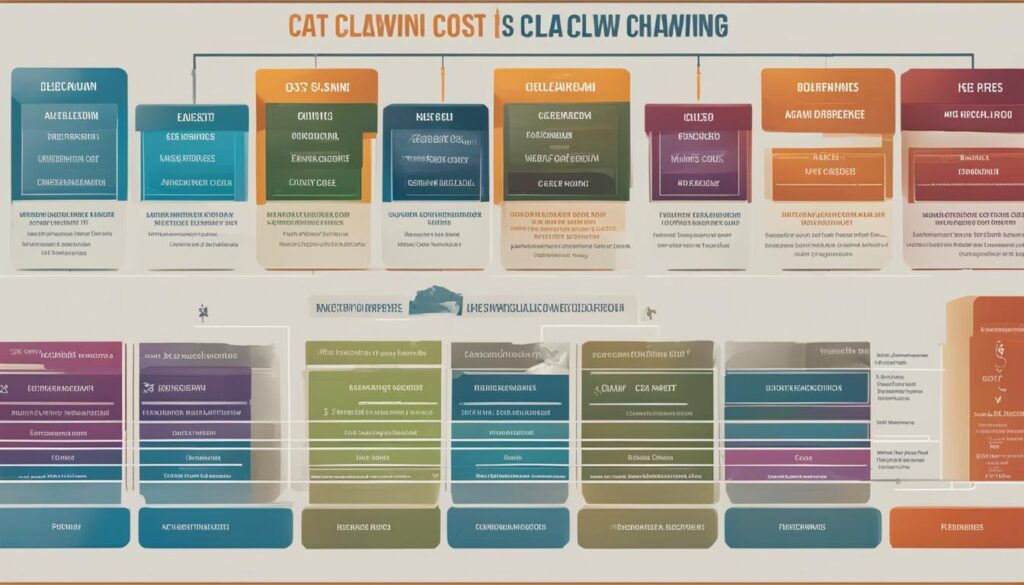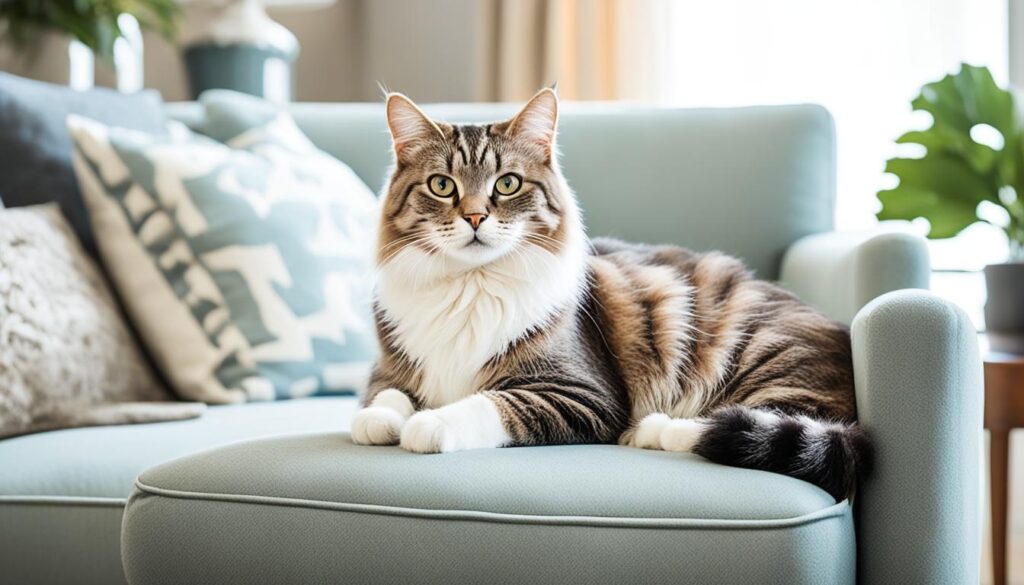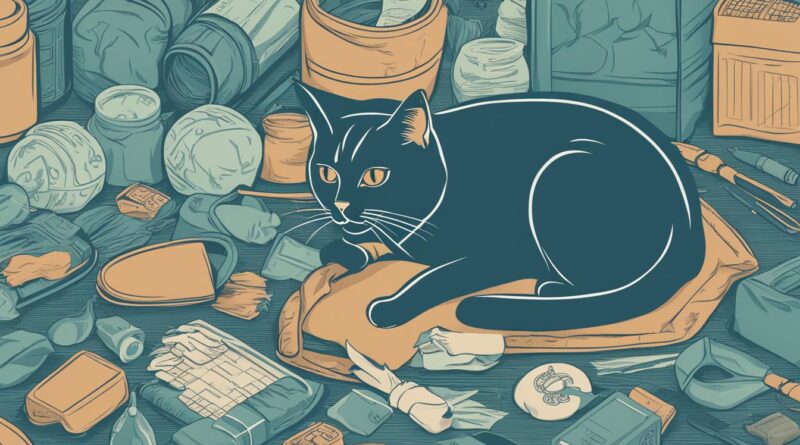Cat Declawing Costs Explained – Learn Now
Are you considering declawing your cat? It’s important to understand the costs involved so that you can make an informed decision. Cat declawing expenses can vary depending on various factors. Let’s explore how much it costs to declaw a cat and what factors influence the pricing.
According to various sources, the price of cat declawing ranges from $200 up to $800 or more. The exact cost depends on factors such as the veterinarian, the age of the cat, and the technique used for declawing. It’s crucial to consider these costs and be financially prepared before deciding on this procedure.
Key Takeaways:
- The cost of declawing a cat can range from $200 to $800 or more.
- Factors such as the veterinarian, cat’s age, and technique used can influence the pricing.
- Consider the costs involved and be financially prepared before deciding to declaw your cat.
What is Included in the Cost
The cost to declaw a cat includes several components. Let’s break down the expenses:
- Pre-testing: This involves a physical examination and additional tests such as blood tests, which can range from $80 to $200 depending on the veterinary clinic.
- Anesthesia: The cost of anesthesia typically ranges from $25 to $75, depending on the cat’s weight and the duration of the surgery.
- Declawing Procedure: The actual declawing procedure can be performed using different techniques, such as onychectomy, disarticulation, or laser surgery, with prices ranging from $100 to $400.
- Aftercare: Aftercare costs may include pain relievers, antibiotics, and additional services, which can amount to approximately $35.
Please note that these are estimated costs and can vary depending on various factors such as the veterinarian’s fees, geographical location, and the specific needs of your cat.
“Understanding the breakdown of cat declawing costs can help you budget for this procedure and make an informed decision for your feline companion.” – Dr. Sarah Johnson, DVM

| Component | Price Range |
|---|---|
| Pre-testing | $80 – $200 |
| Anesthesia | $25 – $75 |
| Declawing Procedure | $100 – $400 |
| Aftercare | $35 (approx.) |
Why Should You Declaw Your Cat?
There are several reasons why cat owners consider declawing their cats. One common reason is to prevent cats from damaging household items through scratching behavior. Scratching is a natural instinct for cats and can lead to torn furniture, shredded curtains, and scratched walls. Declawing can help protect your home and belongings from these potential damages.
Additionally, in cases where a cat has tumors or severe injuries to their paws, declawing may be medically indicated. By removing the claws, the cat can experience relief from pain and discomfort caused by these conditions, leading to a better quality of life.
Some owners also choose to declaw their cats to prevent scratching-related injuries to family members, especially those with weakened immune systems. Cats have sharp claws that can cause deep scratches and puncture wounds, which can increase the risk of infection. Declawing can reduce the likelihood of these injuries and provide a safer environment for everyone in the household.
However, it’s important to weigh the potential benefits against the potential risks and consider alternatives to declawing. Declawing is a surgical procedure that involves the amputation of the last bone of each toe and can result in pain, complications, and changes in behavior for the cat. It’s crucial to thoroughly understand the implications and consult with a veterinarian before making a decision.
Remember, declawing should always be a last resort and exploring alternative solutions, such as providing appropriate scratching surfaces and regular nail trims, is highly recommended.

Benefits of Declawing a Cat:
- Prevents damage to household items
- Relieves pain and discomfort caused by tumors or severe paw injuries
- Reduces the risk of scratching-related injuries to family members
While declawing may offer certain benefits, it’s important to consider the potential risks and explore alternatives that can promote positive scratching behaviors without the need for surgery. By understanding the implications and consulting with a veterinarian, you can make an informed decision that prioritizes your cat’s health and well-being.
When Should My Cat Be Declawed?
Declawing a cat is a personal decision that requires careful consideration. One important factor to consider is the optimal time for cat declawing. The best age to declaw a cat is between three and six months. Most cats undergo the procedure around five months old when their bones are still relatively soft and their paw pads are less developed. Kittens generally recover more quickly from the surgery compared to older cats, as their bodies are more adaptable and resilient.
It’s crucial to plan the surgery in advance and consult with a veterinarian to ensure the best outcome for your cat. The veterinarian will assess your cat’s overall health and consider any specific factors that may affect the procedure. They will also discuss alternative options, such as regular nail trims and providing appropriate scratching surfaces, to help you make an informed decision.
However, it’s worth noting that older cats are generally not recommended to be declawed. The procedure becomes more challenging and may involve a longer recovery time for adult cats. Additionally, older cats may already have fully developed scratching behaviors, which may make it harder to modify their habits after declawing. It’s important to prioritize the well-being and comfort of your cat when considering declawing, weighing the potential benefits against the potential risks.
Benefits of Younger Age Declawing
Declawing a cat at a younger age offers several potential benefits:
- Minimal Behavioral Modification: Kittens are more adaptable and can adjust to behavioral modifications more easily compared to older cats.
- Quicker Recovery: Younger cats tend to recover more quickly from surgery due to their faster healing abilities.
- Reduced Risk of Complications: The procedure may have a lower risk of complications in younger cats, as their tissues are generally more flexible and responsive to surgery.
By choosing the optimal time for cat declawing, you can enhance the overall experience for your cat and mitigate potential risks. Always consult with a veterinarian to determine the best age and approach for declawing, prioritizing the well-being and long-term comfort of your feline companion.
| Benefits of Younger Age Declawing |
|---|
| Kittens are more adaptable and can adjust to behavioral modifications more easily compared to older cats. |
| Younger cats tend to recover more quickly from surgery due to their faster healing abilities. |
| The procedure may have a lower risk of complications in younger cats, as their tissues are generally more flexible and responsive to surgery. |
Will My Cat Be in Great Pain?
Declawing is a surgical procedure that can cause pain and discomfort for cats. Although pain management protocols are typically implemented, there is still a risk of pain after the surgery.
Some cats may experience pain beyond the immediate recovery period, including phantom pain or long-lasting pain due to nerve damage. The loss of their claws can impact their balance and lead to changes in their gait, causing discomfort.
In a study published in the Journal of Feline Medicine and Surgery, it was found that cats who had been declawed experienced a higher rate of adverse behaviors such as biting and urination outside the litter box. These behaviors may be due to pain or changes in their ability to engage in natural scratching behaviors.
Owners should closely monitor their declawed cats for any signs of pain or complications. Signs of discomfort may include limping, reluctance to walk or climb, and changes in behavior such as increased aggression or hiding.
If you observe any signs of pain or unusual behavior, it’s crucial to seek veterinary care as soon as possible. Your veterinarian can evaluate your cat’s condition, provide appropriate pain management, and address any complications that may arise.
| Possible Signs of Pain or Discomfort After Declawing |
|---|
| Limping or favoring certain paws |
| Reluctance to walk or climb |
| Increased aggression |
| Unusual hiding or withdrawal |
| Changes in appetite or drinking |
| Urination outside the litter box |
| Excessive grooming of paws |
Ensuring your cat’s comfort and well-being should be a priority after declawing. Providing a calm and stress-free environment, as well as following your veterinarian’s post-operative instructions, can aid in your cat’s recovery.
Conclusion
When considering whether to declaw a cat, it’s important to weigh the cost and benefits carefully. While the price of declawing can range from $200 to $800 or more, the potential risks and impact on your cat’s well-being should also be taken into account. Instead of opting for declawing, alternative solutions should be explored. Providing appropriate scratching surfaces and regular nail trims can help redirect your cat’s natural scratching behavior.
Furthermore, it’s crucial to be aware of the potential pain and complications associated with declawing. Cats may experience discomfort and exhibit signs such as limping or behavior changes. Consulting with a veterinarian before making a decision is essential to ensure the best interest of your cat’s health and behavior.
Ultimately, the decision to declaw a cat should not be taken lightly. It’s important to consider the long-term consequences and explore alternatives that prioritize your cat’s well-being. By taking into account the cost, potential risks, and the impact on your cat, you can make an informed decision that promotes a healthy and happy life for your feline companion.
FAQ
How much does it cost to declaw a cat?
The cost to declaw a cat can range from 0 to 0 or more, depending on various factors such as the veterinarian, the cat’s age, and the technique used.
What is included in the cost of declawing a cat?
The overall cost typically includes pre-testing, anesthesia, the declawing procedure, and aftercare such as pain relievers and antibiotics.
Why should you declaw your cat?
Some common reasons for cat owners to consider declawing include preventing damage to household items, medically indicated procedures for cats with severe injuries or tumors, and reducing the risk of scratching-related injuries to family members.
When should my cat be declawed?
The ideal time to declaw a cat is between three and six months of age. Most cats undergo the procedure around five months old. Older cats are generally not recommended for declawing due to potential complications and longer recovery times.
Will my cat be in great pain after declawing?
Declawing is a surgical procedure that can cause pain and discomfort for cats. While pain management protocols are typically implemented, there is still a risk of pain after the surgery. Some cats may experience pain beyond the immediate recovery period, including phantom pain or long-lasting pain due to nerve damage. It’s important to monitor a declawed cat for signs of pain or complications and seek veterinary care if necessary.
What should I consider before deciding to declaw my cat?
It’s crucial to carefully consider the potential risks, impact on your cat’s well-being, and explore alternatives to declawing such as providing appropriate scratching surfaces and regular nail trims. The decision to declaw a cat should be made in consultation with a veterinarian and in consideration of the cat’s health and behavior.


